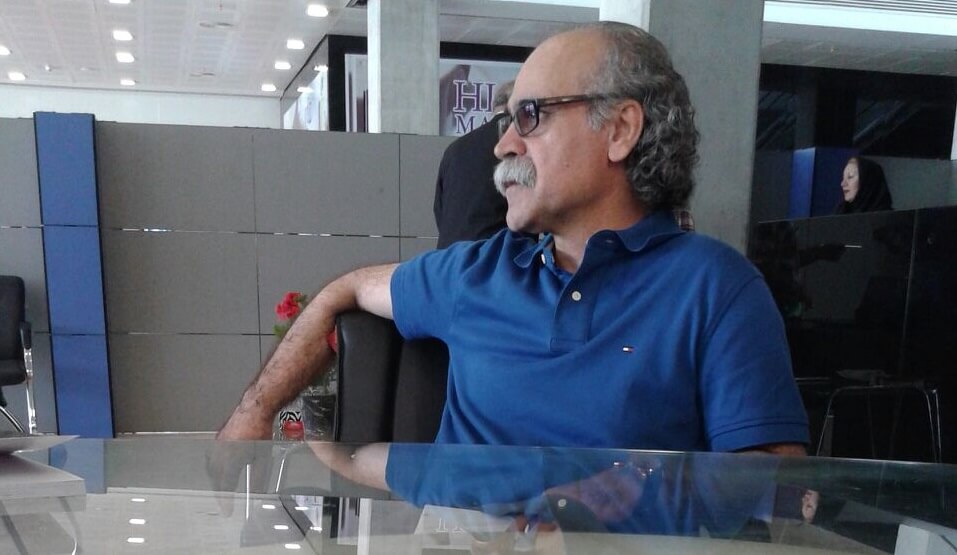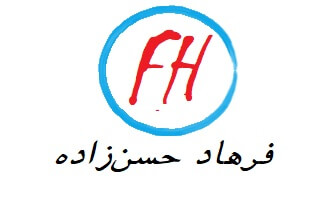Farhad Hassanzadeh was born in 1962 in Abadan, a town in the south of Iran by the side of the Arvand River at Iran Iraq border and one of the main sites of oil extraction and refining. The modern development of this town and its unique and liberal civil ambience in the 1960s made Abadan the paragon of modernization in Iran. In the decade that followed and as the Islamic revolution gained pace, Abadan became the center and the forerunner of national strikes, well establishing its place in the context of political transformations. It was besieged in the 1980s during the first days of Iran-Iraq war, getting almost obliterated in the wartime and contributing the highest number of war migrants. Hassanzadeh spent his childhood and adolescence in this town.
Hassanzadeh began his creative activities at his early teens, a few years before the revolution, by joining literary and artistic institutes for children and adolescents. Under the supervision of the lecturers in these institutes, he started writing plays and stories for his peers and fellow citizens. Afterwards, in high school, he focused more on playwriting. His drama teacher at high school taught him about modern, critical writers and playwrights, especially about Bertolt Brecht’s writing style. When war broke out, Hassanzadeh was eighteen. He had to leave his hometown during the wartime.
Migration and life in some of the largest cities of Iran with their different cultures and social atmosphere, such as Isfahan, Shiraz, Yazd, Andimeshk, Dorud, and finally Tehran, and also having to take on various jobs, from industrial labor to technical services gained him valuable life experiences. Hassanzadeh’s profound understanding of differences, whether due to geography, class, or character, took a clearer shape and matured further as a result of those experiences.
At the same time, though, this migration deprived him of professional literary pursuits. Hassanzadeh remembers this deprivation with bitterness. For years, his passion for literature remained buried beneath the heavy weight of political upheavals and, for Hassanzadeh, who was a war migrant, the idea of returning to literary creativity was a dream that was in complete contrast to the bitter social and political truths surrounding him. Like all war exiles, Hassanzadeh was far from his geographical hometown, but this desolation was doubly imposed on him since he was also kept away from literature, the springboard to his dreams and ideas. Although he managed to improve his graphic and visual perception by learning calligraphy and photography, his general professional career began at the early 1990s, when the war ended. The two significant and decisive historical and political events, namely the revolution and the war, made a deep impact on his mind and soul; in particular the war, the Iraqi invasion, overhauled his destiny. The depth of this impact can be seen in most of his fiction, including his war novels. One of the aftermaths of the war was the dislocation and vagrancy of many of the southerners in Iran, separating Hassanzadeh from his circle of artistic friends. After years of wandering, Hassanzadeh finally became involved in journalism for children in Tehran in 1989 and began working with Iranian children’s and young adult magazines. His focus on writing stories, especially for children and teenagers, began in these years, pulling him into continuous reading and literary creativity. He published his first book entitled The Adventures of the Fox and the Bee in 1991 The manuscripts of the books and plays he had written before were lost in the years of migration, but in working with organizations, magazines, writers, and illustrators in Tehran, and nourished by the plethora of stories that he had stored in his memory during these years, he was able to become an estimable writer in a short time. Hassanzadeh had married in 1989, and in 1991 his son was also born. He considers emotional involvement with his child and the experience of reading children’s books to him as one of the important stages of his growth as an author. Although it seems that in writing stories, Hassanzadeh relies on his personal experiences more than anything, his connection to children of various generations and spheres has never been severed, and his writings have always been praised for reflecting the realities and problems of different generations of Iranian teens. For example, The Computer Crow (1999) was not only his first work about the influence of the internet and cyberspace on children’s lives, but also the first Iranian children’s book on the subject. This endeavor persisted in his other books such as This Weblog Will Be Transferred and made him a vanguard writer in Iran in this field. Hassanzadeh tries to keep himself updated with children’s and teenagers’ ongoing experiences by being continually present at schools, being accessible to his audience online and via public media, and holding story-reading events and practical workshops. As a result, he is virtually one of the best-known figures of children’s literature among his real audience and at schools.
Hassanzadeh, who wrote short stories and poetry at the onset of his career, published his first young adult novel entitled Mashoo in the Fog in 1995, which became the chosen book of the year by the Institute for the Intellectual Development of Children and Young Adults (Kanoon) and was also praised in the Annual Book Fair held by the Ministry of Culture and Islamic Guidance. During his career, Hassanzadeh has published over 110 books in various genres such as short stories, long stories, novels, fables, fantasy, comedy, and biographies. Hassanzadeh’s works mainly comprise children’s and young adult literature, winning him the Golden Moon Award in 2000, an award given to the best writer of children’s and young adult books in the past twenty years. However, his works also include acclaimed, successful writings for adults. For instance, The Backyard, a novel that was nominated for and won numerous awards in 2004 and was critically acclaimed, is a novel in Hassanzadeh’s particular style but targeted at the adult reader, dealing with the disintegration of human relations and the breakdown of friendships and families as a consequence of the 1979 revolution, Saddam’s invasion of Iran, the war, and its aftermaths.
Hassanzadeh has also worked with important children’s literary press, including Soroush Nojavan, Soroush Koodak, Aftabgardan (the first children’s newspaper in Iran), and Keyhan Bacheha, having a hand in their foundation and growth. Hassanzadeh has been a journalist and a writer for many years in the most important children’s press organization called Docharkheh Magazin.
In this magazine, Hassanzadeh tried to keep perpetually in touch with the readers, whether by correspondence or face-to-face conversations, discovering the most enigmatic problems on their mind and using them in the stories that he unwaveringly writes for each issue of the magazine. Writing about the deep impact of the digital revolution and multimedia space is one of the results of this connection with the readers. Apart from writing for children, Hassanzadeh has also played a pivotal role in fostering periodicals that are about children’s books. He was the executive editor of Research Quarterly for Children’s and Young Adult Literature for four years, the most important magazine engaged in the criticism and review of children’s literature in those years, working for which made Hassanzadeh familiar with theoretical and critical ideas. However, Hassanzadeh’s civil pursuits are not limited to the press. He has been one of the founder members of the Association of Writers for Children and Youth, an association that is now the most important civil and trade association for the writers of children’s and young adult literature. He has also been selected unanimously as a board member for three terms. Moreover, he has tried to update traditional story making techniques by rewriting ancient legends and fables and, in this manner, has endeavored to put their technical and cultural potentials to use in this way.
Writing the biographies of historical figures in the form of fiction for young adults is another method that he has chosen for establishing cultural ties with teenagers. Furthermore, he has twice been the secretary of the Home Libraries Festival, a civil measure taken to expand home libraries and encourage book reading habits in neighborhoods and across town. He has cooperated as a judge in the festivals of story writing, screenwriting, theater, storytelling, children’s book illustration, etc.
In recent years, apart from the previously mentioned genres, Hassanzadeh has been particularly busy with rewriting and retelling stories. Hassanzadeh’s rewritings are artistic cultivations of pre-existing stories, told in a language that today’s adolescents find familiar. Modernizing old works of Persian literature is a long-established genre in children’s and young adult Persian literature. Hassanzadeh has offered successful and acclaimed instances of this genre by rewriting the works of some of the most important Persian poets: Ferdowsi, Rumi, Saadi, and Nezami in the form of modern novels, story illustrated stories for young children. At the same time though, his interpretation of retelling and rewriting goes beyond the demarcations of this genre, and, in The Children of Depths, he experiences with a different type of rewriting. The Children of Depths is based on the memoir of one of the best social observers of children’s and adolescents’ prisons or Iran Juvenile Delinquents Correction Center. Hassanzadeh has transformed this memoir to short stories.
Mehrdad Ghaffarzadeh has made a film adapted from the short story “The Longest Ruler in the World,” in part of which Hassanzadeh himself plays the role of a writer. Recently, he has started collaborating with Mohammad Ali Talebi, a renowned Iranian filmmaker for children and teenagers, and is writing a script for a series based on the novel The Moon’s Guest and a film script based on the novel Ziba sedayam kon (Call Me Ziba). In addition, the cinematic department of the Institute for the Intellectual Development of Children and Young Adults (Kanoon) has approved the production of a film adapted from the novel Hasti.
Also, in recent years, Hassanzadeh has been able to create popular characters in Iranian children’s and young adult literature, which does not have a character-based narrative tradition. For example, children have favored Kooti Kooti, and Hasti has been popular among teenagers. This has bestowed a particular feature on the relations between Hassanzadeh and his audience. He still maintains his relations with his audience online and also in book-reading sessions at schools, institutes, and NGOs and has been able to achieve the highest honors in Iranian children’s and young adult literature in the past ten years.
His works have won awards time and again from numerous organizations, such as Islamic Republic of Iran’s Book of the Year, the Children’s Book Council of Iran, the Institute for the Intellectual Development of Children and Young Adults (Kanoon), Flying Turtle Award, the Association of Writers for Children and Youth, the Cultural Society of Children’s Publishers, and Young Adult Audience Award.
Farhad Hassanzadeh is now a national figure and a renowned literary, cultural, and civil personality, as well as one of the most popular writers of children and young adult works in Iran; so much so that the national message sent on the International Children’s Book Day, which is always composed by one of the distinguished figures involved with children, was sent by him to Iranian children in the present year (2016).
The continuous presence in the field of writing, promoting reading and his popularity among the audiences caused Hassanzadeh to be nominated for international awards by official institutions, which include: The nominee for the Astrid Lindgren Award by the Institute for the Intellectual Development of Children and Young Adults (Kanoon) in 2017. He was chosen for the Astrid Lindgren Award by the Iranian Children’s Book Council in 2018, 2019, 2020 and 2023. Hassanzadeh made the final list (shortlist) of the Andersen Award in 2018 and 2020 and received a certificate of appreciation from the officials of this award.
Hassanzadeh was present in Frankfurt Book Fair this 2016, representing the Association of Writers for Children and Youth and approved by the Ministry of Culture and Islamic Guidance, as a national figure and on behalf of Iranian children’s and young adult writers, and he delivered a speech there. In this year, he also made two speeches in the University of Belgrade upon their invitation, one on “The Rise of Children’s Literature in Iran” and the other one on “The Impact of War on Children’s Literature in Iran.”
In parts of his speech, he mentioned some of his motives behind writing for children and the connections between his life and his time with the works he had created: “First of all, every author writes some part of himself. In the works of every writer, one can find a piece of the writer’s real present or past and travel to the mazes with him or her. A part of my life, my teen years, coincided with years in which two major historical events occurred: first, the 1979 revolution and secondly, a war that started two years after the revolution and lasted eight years… The second point is that I think perspective matters a lot…My perspective has always been different from that of the ones who look at this phenomenon in an idealistic and sloganized manner. For me, writing of war has always been accompanied with a humane, anti-violence view… The third point is that children in each country should learn about the historical and onerous epochs of their land. This learning is not limited to history books or textbooks. What novels and stories have embedded in them is the blend of truth and life. The fourth point is that Iran is situated in the Middle East, the perpetual center of political and military crises. Since literature reflects the quintessence of a country, writing about such matters is normal.”
And Hassanzadeh’s art is to give meaning by expressing contradictions. He draws out love and peace from the depths of war and thus makes the joy of peace more meaningful.
In his speech in the University of Belgrade, He spoke of the connection between today’s literature in Iran and the ancient traditions of Persian storytelling and pointed to the connection between the extant stories in national and local cultures and the new forms of narrating stories, “The modern form of children’s and young adult literature in Iran has almost 100 years of history under its belt, but the tree we see today has a root that goes back thousands of years. Iran is an ancient land with a history full of ups and downs, with ancient legends and myths. One can still find some relics from those ages on some mountains and plains, tangible, visible relics. How about intangible, invisible relics? In my opinion, today’s literature of Iran is a train that rides on the tracks of ancient literature. Some writers and poets have rewritten a number of stories and legends from the past, turning them into books. Another segment of today’s literature is based on oral works, such as stories, lullabies, fables, and jokes. The tree of today’s literature has its roots in those stories, fables, and myths.”


